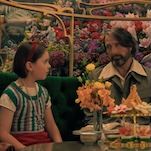“There are worse things than murder,” Bonnie says to a wasted Laurel over a game of pool. Her ominous declaration is the episode’s titular line, and it’s also an idea How To Get Away With Murder has continually explored—with varied levels of success. Though murder is a pretty regular occurrence in the lives of Annalise Keating and her minions, How To Get Away With Murder examines the relationship between violence and power beyond just murder, and this show is especially sharp in its stories of physical and sexual abuse, depicting survivors as complex individuals instead of monoliths.
In “There Are Worse Things Than Murder,” Annalise’s clinic takes on the case of Irene Crawley, a woman up for parole who has served 32 years in prison for killing her husband with a hammer claw. But Annalise informs the class that the woman was physically and sexually abused for years by her husband, a fact that was kept out of her initial trial because the law did not sufficiently protect victims of domestic abuse at the time. The specific horrors of the abuse she lived through comes to light near the end of the episode, and it’s not the first time How To Get Away With Murder has sunk its teeth into a compelling and harrowing tale of survival. Bonnie and Annalise were both abused by men in their own family. Annalise has represented other abused women in the past. And the case this time around similarly treats Crawley as a complex and visceral character instead of just painting an abuse survivor in broad strokes. Her final testimony is riveting, sharply written, and likely to stick with me for days to come. The weight of this character’s pain guts.
This week, How To Get Away With Murder spends enough time with its case of the week, infusing it with emotional stakes and nuanced ideas that make it feel like a more significant part of the episode’s narrative than last week’s did. The laws have changed, but stigma against victims persists, and Connor—who scores the first chair position this week—has difficulty convincing the parole board of his client’s suffering. The parole board’s dismissal of Crawley, their suggestion that the abuse is only now being presented when it wasn’t at her original trial because she is trying to take advantage of new laws, is an act of violence in and of itself. Every time Crawley’s forced to fight for parole, she’s forced to relive through the horrors she experienced—another act of violence.
The men on the parole board inform her that her candor in her testimony won them over, but their words don’t come off as a victory. They only reiterate the men’s cluelessness about what Crawley had to go through in order to share her story, their ignorance of what it means to revisit trauma like that. All she needed to do was tell the truth. Yeah, well it’s not that simple, especially when victims are so often met with doubt and scrutiny, which was the general vibe of the parole hearing at its onset. The board asks her why she killed her husband instead of leaving him, another manifestation of their ignorance and the fact that even though they’re the arbiters of her fate, they can never fully understand what Crawley went through and what could drive a person to kill in this way. The episode broadens its scope of trauma through another character: the dead abuser’s sister. Annalise astutely realizes this woman was abused, too, and when she confronts her, the sister explains that he was a horrible man but that no one deserves to die like that.
“Don’t speak for her,” Annalise warns Connor when he becomes overexcited at the hearing and tries to argue on the behalf of his hardened client. With that quick line, she effectively conveys that Crawley deserves agency, deserves the chance to tell her story for herself and on her own terms. Connor genuinely wants what’s best for her and for justice to be served, but speaking for her only further invalidates her autonomy. “There Are Worse Things Than Murder” is quite possibly Jack Falahee’s best episode to date. Connor’s emotions throughout the episode are fully felt—his insecurities in his personal life colliding with his insecurities in his professional life. So often, this show leans into the idea that the Keating Five have absorbed some of Annalise’s worst qualities. As a group, they feed into each other’s darkness. But “There Are Worse Things Than Murder” shows a slightly different side of Annalise’s impact on her students. They learn terrible behavior from her, but they learn some good, too. When Connor speaks passionately with little regard for decorum, he channels that unflinching intensity that Annalise often reaches in court when she’s going up against a broken and unjust system.
In fact, later in the episode, she shows off that fiery conviction when the administration naively attempts to suspend her. The episode is uncharacteristically vague in its portrayal of Annalise’s emotions. Davis is excellent as always, but it’s not totally clear where the character’s head is at other than just general uneasiness, which ebbs and flows throughout the episode. Her scenes with Wes are especially confusing, and Wes is increasingly detached from the story. But in that scene with the university president, Annalise is wholly convincing, embodying the core traits of this character.
How To Get Away With Murder remains sharp in its racial commentary. Annalise tells her students that the parole board will be made up of white men, because according to her, “it’s always white men.” She turns out to be right. In an even more trenchant moment, Michaela bluntly explains to Asher why they can never be together in a real capacity. Asher tries to insist that he has changed, that he is learning more and more about privilege and race and identity. But Michaela shuts him down, saying she can’t be his teacher. The back-and-forth between Asher and Michaela is one of the episode’s small subplots, but Michaela’s words bring to light the notion that people of color shouldn’t be expected to teach white people about racism. Racism isn’t just a plotline on How To Get Away With Murder. It’s a pervasive part of this show’s universe just like it’s a pervasive part of the real world. The characters talk about race in a way that feels real.
As usual, it’s these smaller character moments that stand out. How To Get Away With Murder can be very fun in its more outrageous twists, and “There Are Worse Things Than Murder” certainly has its soapy moments. Looking like a villain from a horror B movie—his face mangled from his fight with the assassin Annalise sent his way—Frank blows up a car with the assassin’s body inside. Murder’s sexy side is alive and well, too, with Nate and Annalise still boning on the regular and Asher putting his mouth to good use for once by going down on Michaela. But the best subplot of the episode is its most grounded and emotionally complex one: Connor and Oliver’s breakup. Oliver dumped Connor at the end of last week’s season premiere, but the breakup continues to unfold in “There Are Worse Things Than Murder” in a way that feels real, devoid of the heightened stakes Murder frequently relies on to ramp up the drama.
The drama of Connor and Oliver’s deteriorating relationship is real drama—complicated but not embellished or forced. Breakups on television usually unfold too neatly, but this one is messy in all the right ways. Connor and Oliver are no longer dating, but they still live together, because moving out isn’t that simple. Ending a relationship in general is rarely a simple thing, especially when the two people still obviously care for one another. No one cheated, though that’s the conclusion other characters jump to when they hear about the split. No one did something horrible that led to an instant breakup. The motivations are more murky than that, less plotty. A breakup shouldn’t feel like mere plot; it should feel like character development, and with Connor and Oliver, it does. How To Get Away With Murder presents the reality of the post-breakup processing, the renegotiation that comes with changing the terms of your relationship with someone. Oliver’s the first person Connor calls when he has a major break in his case. And Oliver answers willingly, comfortable with talking to Connor, with celebrating with him. Connor kisses Oliver and promises to do anything to save the relationship, and even though Oliver had just been perfectly willing to maintain a certain level of intimacy with Connor, he remains steadfast in his belief that they shouldn’t be together. He wants him to leave him alone, but he still protests when Connor says he’ll pack his things. He wants out of the relationship, but he doesn’t want Connor out of his life completely. Breakups are full of such contradictions, and How To Get Away With Murder tackles them beautifully. Whenever the show taps into compelling relationship dynamics, it gives urgency and depth to the rest of the narrative. All of that’s more interesting than, say, finding Frank or even finding out who’s hanging all these threatening flyers.
Stray observations
- As promised, we find out one character who’s safe in the flashforwards. Oliver survives the fire at Annalise’s house. And Annalise is arrested but not before she slips Oliver a phone and asks him to wipe it clean.
- “I want to give you another double.” Okay, Michaela’s sex life is pretty great right now.
- Hopefully Meggy will start to feel like a fully realized character soon. I like her! But her scenes with Wes have so far been completely flat.
- Annalise is back to acting shady as hell around Wes.
- It looks like we’re finally going to get to know Laurel’s dad a little better.
- Connor’s hair is very good this season.
- Laurel and Bonnie make for the weakest parts of this episode. I’m all for these two hanging out and shooting pool, but I’m just not at all invested in anything that they’re up to. And so far this season, both characters are just kind of shuffling around at the periphery of everyone else’s stories.
- Eve is all over the Mahoney case, but I will scream WHERE IS EVE? every week until she makes an actual appearance on the show.









































